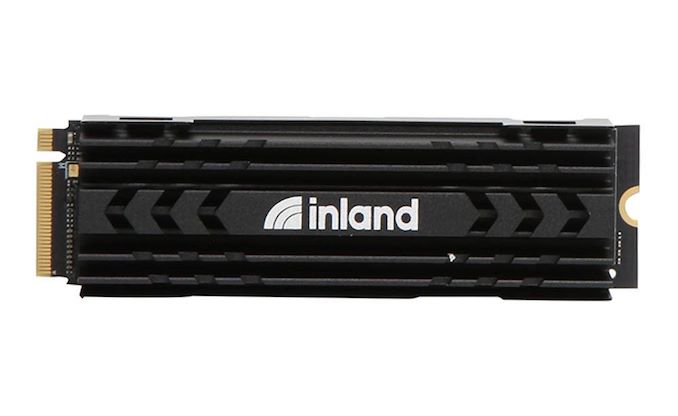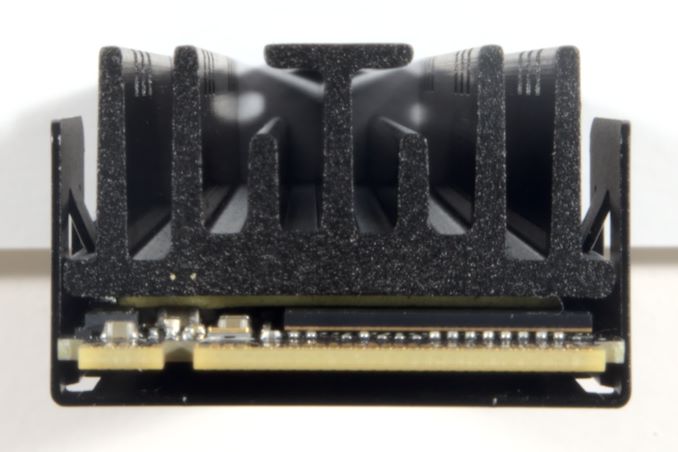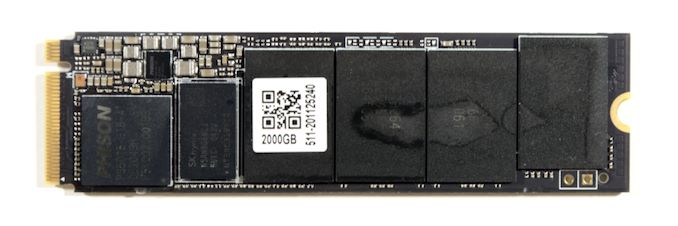The Inland Performance Plus 2TB SSD Review: Phison's E18 NVMe Controller Tested
by Billy Tallis on May 13, 2021 8:00 AM EST
Phison kicked off the transition to PCIe 4.0 for storage in 2019, and dominated the high-end SSD market for over a year with the only available PCIe 4.0 solution. There are now several competing PCIe 4.0 NVMe SSDs and controllers that handily outperform the Phison E16, but Phison has stayed competitive by bringing out a second-generation PCIe 4.0 controller, the E18. Today we're looking at one of many drives built around that controller: the Inland Performance Plus 2TB.
The Inland brand is owned by the parent company of American retailer Micro Center. Most or all Inland-branded SSDs are simply Phison reference designs with little or no customization beyond cosmetics. Inland SSDs are frequently great value options—especially for Micro Center's in-store only deals, but even their online prices tend to be very competitive. Part of the discount comes from their tendency toward shorter warranty periods: the Inland Performance Plus has only a three year warranty despite being a high-end flagship model. Fortunately, the total write endurance rating is the same as competing drives that carry five year warranties, and the SSD hardware itself is identical to other brands selling the same SSD reference design under different heatsinks and labels.
As part of the second wave of PCIe 4.0 SSD controllers, the Phison E18 aims to use substantially all of the performance available from the PCIe 4.0 x4 interface: sequential transfers up to around 7.4 GB/s and random IO up to about 1M IOPS. Hitting that level of performance while staying within M.2 power delivery and thermal dissipation limits required migrating to 12nm FinFET fabrication from the cheaper 28nm widely used by PCIe 3.0 SSD controllers and by the Phison E16. But even so, the Phison E18 can draw more power than the E16 controller because the increase in performance is so large. Competition for the Phison E18 includes in-house controllers used in the latest flagship consumer SSDs from Samsung and Western Digital, newcomer Innogrit's IG5236 Rainier controller, and Silicon Motion's upcoming SM2264 controller.
| Phison High-End NVMe SSD Controller Comparsion | |||||||
| E12 | E16 | E18 | |||||
| Manufacturing Process | 28 nm | 12 nm | |||||
| CPU Cores | 2x Cortex R5 | 3x Cortex R5 | |||||
| Error Correction | 3rd Gen LDPC | 4th Gen LDPC | |||||
| DRAM | DDR3/4 | DDR4 | DDR4, LPDDR4 | ||||
| Host Interface | PCIe 3.0 x4 | PCIe 4.0 x4 | |||||
| NVMe Version | NVMe 1.3 | NVMe 1.4 | |||||
| NAND Channels, Interface Speed |
8 ch, 667 MT/s |
8 ch, 800 MT/s |
8 ch, 1600 MT/s |
||||
| Max Capacity | 16 TB | 16 TB | 16 TB | ||||
| Sequential Read | 3.4 GB/s | 5.0 GB/s | 7.4 GB/s | ||||
| Sequential Write | 3.2 GB/s | 4.4 GB/s | 7.0 GB/s | ||||
| 4KB Random Read IOPS | 700k | 750k | 1M IOPS | ||||
| 4KB Random Write IOPS | 600k | 750k | 1M IOPS | ||||
| Controller Power | 2.1 W | 2.6 W | 3.0 W | ||||
| Sampling | Q2 2018 | Q1 2019 | Q1 2020 | ||||
| Retail SSD Availability | Q4 2018 | Q3 2019 | Q4 2020 | ||||
The Inland Performance Plus does not quite hit the theoretical limits of the Phison E18 controller. The 1TB model is clearly handicapped on some performance metrics compared to the 2TB model, but even the latter is only rated for 7GB/s sequential reads and 650-700k IOPS instead of 7.4GB/s and 1M IOPS. This mostly comes down to the Inland Performance Plus and other current E18 drives using 96L TLC NAND with 1200MT/s IO between the NAND and the controller, while the E18 can support up to 1600MT/s IO. A new round of E18-based products will start hitting the market soon using Micron 176L TLC that operates with the higher IO speed and should bring some other performance and efficiency improvements. We expect some of these new drives to be announced at Computex next month.
| Inland Performance Plus SSD Specifications |
||||
| Capacity | 1 TB | 2 TB | ||
| Form Factor | M.2 2280 PCIe 4.0 x4 | |||
| Controller | Phison E18 | |||
| NAND Flash | Micron 96L 3D TLC | |||
| Sequential Read (GB/s) | 7.0 | 7.0 | ||
| Sequential Write (GB/s) | 5.5 | 6.85 | ||
| Random Read IOPS (4kB) | 350k | 650k | ||
| Random Write IOPS (4kB) | 700k | 700k | ||
| Warranty | 3 years | |||
| Write Endurance | 700 TB 0.6 DWPD |
1400 TB 0.6 DWPD |
||
| Retail Price (In Store Only) | $189.99 (19¢/GB) |
$379.99 (19¢/GB) |
||
Like most drives using the Phison E18 controller, the Inland Performance Plus comes with a fairly substantial heatsink installed. The controller package is small enough to share space with a DRAM package and four NAND packages on the front of the PCB, which means there's a lot of heat concentrated in a small area. (The Inland Performance Plus also has DRAM and NAND on the back of the PCB.) PCIe 4.0 has barely started showing up in laptops and using the full performance of a drive like the Inland Performance Plus requires more power than most laptops are able to sink away from their M.2 slots, so it's reasonable to regard this drive as pretty much desktop-only.
The Competition
The most important competitors for the Inland Performance Plus are other Phison E18 drives and the current flagship PCIe 4.0 drives from Samsung and Western Digital. We have fresh results in this review for the Samsung 980 PRO, retested with the latest 3B2QGXA7 firmware. We've also included results from some older top of the line drives: the Intel Optane 905P and Samsung 970 PRO (their last consumer NVMe drive to use MLC NAND), and the Silicon Power US70 representing the first wave of PCIe 4.0 drives that used the Phison E16 controller.
| WD Black SN850 | PCIe 4.0 x4 | WD Custom G1 | 96L TLC |
| Samsung 980 PRO | PCIe 4.0 x4 | Samsung Elpis | 128L TLC |
| Silicon Power US70 | PCIe 4.0 x4 | Phison E16 | 96L TLC |
| Intel Optane SSD 905P | PCIe 3.0 x4 | Intel Custom | 3D XPoint G1 |
| Samsung 970 PRO | PCIe 3.0 x4 | Samsung Phoenix | 64L MLC |
The rest of the drives included in this review are more mainstream models, mostly PCIe 3.0 drives, some with four-channel controllers instead of the usual eight for the high-end, and even a few with QLC NAND. This includes the Inland Premium, which is based on the Phison E12S and TLC NAND.
| Inland Premium | PCIe 3.0 x4 | Phison E12S | 96L TLC |
| SK hynix Gold P31 | PCIe 3.0 x4 | SK hynix Custom (4ch) | 128L TLC |
| Samsung 970 EVO Plus | PCIe 3.0 x4 | Samsung Phoenix | 92L TLC |
| WD Black SN750 | PCIe 3.0 x4 | WD Custom G1 | 64L TLC |
| HP EX950 | PCIe 3.0 x4 | SM2262EN | 64L TLC |
| Kingston KC2500 | PCIe 3.0 x4 | SM2262EN | 96L TLC |
| Intel SSD 670p | PCIe 3.0 x4 | SM2265 (4ch) | 144L QLC |
| ADATA Gammix S50 Lite | PCIe 4.0 x4 | SM2267 (4ch) | 96L TLC |
| Corsair MP600 CORE | PCIe 4.0 x4 | Phison E16 | 96L QLC |

















118 Comments
View All Comments
Spunjji - Friday, May 14, 2021 - link
Yes, that's why I said "most of us". I know there are use cases that benefit from them, but the majority of the time they don't apply to a majority of users.jabber - Friday, May 14, 2021 - link
Yeah you are correct, 'most users' do not notice and most don't need the speed but you will always get the one or two who, for some reason, choose to work with 8K video all day and think they are 'most users'.James5mith - Thursday, May 13, 2021 - link
Please add one of the new 5800x Optanes into the mix. I would like to see what Optane + PCIe4.0 can do as far as sustained performance.It's really sad that none of these drives can maintain performance except for the old 970 Pro and the Optane.
mode_13h - Thursday, May 13, 2021 - link
> Please add one of the new 5800x Optanes into the mix.It would be amusing to see a 4.3M IOPS drive compared to consumer SSDs. However, the pricing on those things is pretty nuts. If such performance is worthwhile for you, you already know you want one.
That said, I'm always interested in seeing cutting edge tech put to the test.
Tomatotech - Friday, May 14, 2021 - link
> maintain performanceAbsolutely not needed for the average price-sensitive user. It’s like buying a 40-ton truck instead of an average family car. And the average family car will outperform the truck in acceleration, top speed, fuel economy, and ease of storage / parking.
There’s many drives available for people who need 100% sustained performance or other industrial metrics and they’re going to cost a bit more.
DigitalFreak - Thursday, May 13, 2021 - link
I'm waiting on DirectStorage before I upgrade.mode_13h - Thursday, May 13, 2021 - link
Why?RSAUser - Friday, May 14, 2021 - link
Because there is no real-world gain for most people going from a normal PCIe 3 SSD to PCIe 4 SSD right now, they're within ms of each other.If DirectStorage starts taking off, it could maybe have a more noticeable impact in terms of texture loading, etc.
mode_13h - Saturday, May 15, 2021 - link
I guess it also depends on what you're upgrading from.It amazes me how some people complain that it's not worth upgrading a CPU (for example), when they have one from the preceding generation! I'm like: well, join the crowd! Most of us keep hardware for *multiple* generations.
So, I find it's also worth keeping in mind that people complaining that it's not worth upgrading might be bringing unrealistic expectations.
thestryker - Thursday, May 13, 2021 - link
I'm not sure the feasibility, but I'd be really curious to see how the PCIe 4 SSD performance varies between AMD and Intel. I know some of Intel's nebulous marketing materials had suggested RKL was better than the Ryzen alternatives, and while I highly doubt that I haven't seen any reviewers test out the same drive on both platforms.I'd also like to second that dream that you'll be able to run a P5800X through the test suite.